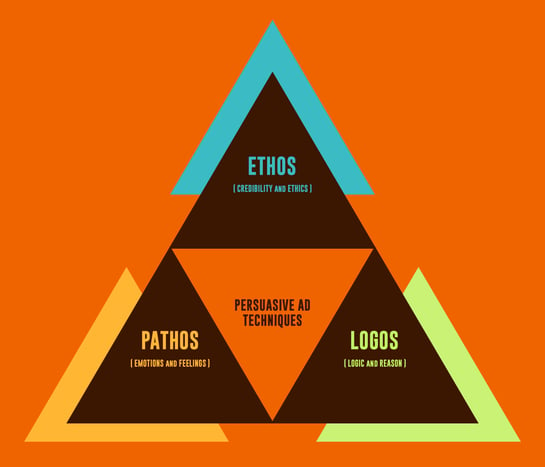

How do you make your prospective customers stop and pay attention to what your brand has got to offer?
How do you get your prospects to act and complete the desired call-to-action? The answer is often rooted in writing compelling copy.
All businesses need copywriting. Copy explains your products to prospective customers, persuades users to follow you on social media, to sign up for your email newsletter, or entices them to make a purchase on your website. Without compelling copy, you wouldn't be able to explain all the benefits of your product and show why your business is the perfect solution for your audience.
Creating perfect copy starts with understanding the fundamentals of copywriting. To help you get started, this guide includes everything you need to know about the art of writing compelling copy.
Studies show that eight out of 10 people read headline copy alone, and only two read the rest. That is why writing attention-grabbing and compelling copy is as important as ever. To get your audience to read past the headline, you must learn to create unique copy that is relevant and informative.
Copywriting is the process of creating written copy (content) with the purpose of increasing conversions and ultimately increasing revenue. It is the art of writing a compelling copy that addresses readers’ pain points and emotions with the primary goal of making a sale.
Copywriting can help you reach all members of your target audience at once and deliver a sales message. It also lays a foundation for your content marketing efforts, search engine optimization (SEO), and growth hacking techniques. By writing compelling copies, you can present customers with an offer that will prompt them to make a buying decision. This way, copywriting is essential for boosting your conversion rate and increasing profits.

A common misconception about copywriting is that it only involves creating written content. In fact, copywriting refers to any content that has a copy as an underlying mechanism. For example, creating promotional materials like videos, images, sales letters, and ads can all be considered copywriting.
You've probably heard the terms copywriting and content writing many times. Even though the two concepts refer to different processes and content types, they are commonly confused with one other.
Knowing the difference will help you find and hire a professional that suits your needs. Also, writing the right type of copy for the right personas will help you achieve the biggest impact and ultimately increase profits.
So, what is the difference between copywriting and content writing? Content writing and copywriting are equally important for your business, but are distinctly different subcategories of writing. While the two share a few common traits, the concepts differ in purpose, characteristics, and content types.
Copywriting is the process of creating copies with the purpose of facilitating conversions, making a sale, and ultimately increasing revenue. Unlike content writing, copywriting is linear, strategic, and intentional. Copywriters typically end their copy with a singular call-to-action (CTA) that prompts readers to buy or to opt in.
Here are some common examples of pieces created by copywriters:
Content writing is the process of creating content with the purpose of building up interest, creating engagement, and ultimately increasing customer loyalty. Unlike copywriting, content writing is multidirectional. It creates a conversation with readers and often links multiple sources and includes multiple CTAs.
Here are some common examples of pieces created by content writers:
While there is some overlap, the two concepts are fairly different. People confuse them because the two are commonly implemented by marketers. Also, both copywriters and content writers create content for specific target audiences and curate pieces based on certain criteria.
Besides, both content writing and copywriting are SEO-focused. This means that both content writers and copywriters optimize pieces to increase the quality and the quantity of traffic flow to the website through organic search results.
A good copywriter will write every single sentence in a way that entices readers to read the next sentence. They will guide the audience through a buying experience with the end result of completing the call-to-action. But how can you achieve that? Following these tips will help you write impactful and compelling copies that entice readers to continue exploring your content.
A good lead-in copy sets the tone for your text and allows readers to move smoothly on to the next part of the piece. The purpose of a lead-in copy is to get readers to read the first paragraph. So, for your lead-in copy to be effective, it must grab attention and prompt users to learn more about what you have got to offer.
Want to learn a lead-in copywriting hack? Starting out with a question is a great way to get your readers to pay attention to your copy. Notice how we used a question at the beginning to grab your attention and introduce what follows next. By asking relevant questions, you stop your readers and say "Hey! Look at me! I have a question for you!"Ask questions like “Who else wants to [...]?” or “Would you like to [....]?” to address readers directly and show what is in it for them.
Another way to grab readers’ attention by using words that describe the novelty and freshness of your solution. How many of you clicked on a Facebook ad that said "New discovery" at least once? The truth is that most of us did. The secret behind the "New discovery" kind of ads is their appeal to the fresh solutions. People tend to be interested in everything innovative, so you want to use phrases that are novelty-focused and catchy, yet not clickbaity.
Every audience requires an individual approach. Here is an example. Copy written for college graduates will differ from copy written for the new parents. College graduates have different needs, expectations, and pain points than new parents. While college graduates may be looking for services that can help them find an entry-level job, new parents are likely suffering from insufficient sleep and looking for apps for a better bedtime.
You will not succeed if you try to target college graduates with copy relevant for new parents and vice versa. That is why before starting to write a copy, it is important to take your time to understand your target audience.
Your audience is going to skim, scroll, and scan through your content. In order to facilitate your readers to invest move time, your writing must appeal to the audience and use their language to communicate your offering. People love information that is easy to consume and that gets the point across. Your writing should never be confusing for readers or send them to the dictionary.
Studying the target audience is key. Where do they prefer to get their information from? What language is used in their favorite sources? Which keywords do they type into Google to search for content? Answering these questions and questions alike will help you find your audience’s language and use it in your own copy.
A good copywriter knows how to create a compelling copy that connects to the audience on multiple levels. Ideally, your copy should connect with your readers emotionally and rationally. To achieve that, you must take your readers through the logical sequence that resonates with their needs, expectations, and pain points.
Building strong connections with readers goes back to understanding your target audience. To create a compelling copy, you must understand your audience and their thoughts.
To better connect with your readers, you can implement the rhetorical triangle. This is the framework coined by Aristotle that emphasizes the three modes of persuasion.

Besides understanding your audience, you must thoroughly understand the product you are pitching. The detailed knowledge of the product allows you to present it more beneficially. Plus, when you know all the strengths and weaknesses, it greatly contributes to the overall credibility of your copy.
Now, as you have learned what copywriting is, let’s dig deeper into understanding different copywriting types. Creative copywriting, sales copywriting, SEO copywriting, and technical copywriting all differ from one another. They all have specific characteristics, goals, objectives, and other nuances. By learning the difference between different types of copywriting, you can discover which type is best for your business.
The main job of a creative copywriter is to come up with content that is enjoyable and entertaining to read. Creative copies have a unique structure and do not aim to increase search engine ranking or drive a sales pitch. The main objective of a creative copywriter is to make an emotional connection with the readers.
Unlike traditional copywriters, creative copywriters do not create task-focused content. Instead, they write reader-focused copies that help you build strong relationships with your audience.
Unlike creative copywriting, sales copywriting has a specific goal of pitching the products to the audience. By writing sales copy, you can help customers make more informed decisions and highlight the benefits of your product.
Sales copies are built around the idea of what’s in it for the audience. Too often, copywriters get caught up in explaining the features of the products and forget to communicate the value of the product. Yet customers are often less interested in data points and features. The value offered by your products is what they want to see in your copy.
If you are planning to implement sales copywriting, make sure to highlight the value of your product. Don't get caught up in explaining the technical aspects, because there's a different type of copywriting for that.
SEO copywriting is another copywriting type that aims to achieve the following:
SEO copywriting is typically used in the development of landing pages, product categories, and product descriptions. For your SEO copy to be effective, it must be useful, valuable, and relevant to the readers and include specific keywords to get the traffic flowing to your site.
When creating SEO copy, always remember that people, not search engines, come first. Think of the increased traffic flow as the byproduct of high-quality, relevant, and engaging copies.
Unlike other copywriting types, technical copywriting focuses on the audience that has an in-depth understanding of the product-related sector. Technical copywriters create texts that are data-driven and use a specialized language compelling to the target audience.
Here are some examples of content pieces that are typically written by technical copywriters:
To create effective technical copy, they must be compelling and address a specific competent audience with an in-depth understanding of the topic.
By now, you should understand the fundamentals and different types of copywriting. But how do you move from theory to practice? The answer is by developing copywriting skills.
Oftentimes, copywriting job listings are filled with words like “creative,” “imaginative,” and “motivated”. While all of these characteristics are important in copywriting, they do not describe particular skills. If you want to come through in the art of writing copy, begin by developing these four skills.
With our attention spans shrinking down to eight seconds, the ability to write short-form and succinct copy is as important as ever. Here are some tips that will help you write coherent short-form copy.
Stellar research skills are what define the most successful copywriters. When you’re assigned a topic, you should know exactly which platforms and websites are best to dig into to find the information you need. You should have a plethora of reliable resources (not Wikipedia) at your disposal.
To help you get started, here are some internet-savvy skills worth developing:
If you’re struggling to develop research skills, there are many learning communities, like Udemy and Skillshare, and online resources that will help you improve your topic and niche research skills.
A good copywriter knows exactly when to use a quick witty joke. Humor isn’t rare in copywriting because it’s a powerful marketing tool. Also, jokes are engaging, which allows you to better connect with your audience. Understanding the audience is key in using humor in your copy. Learn what makes your readers react and use the corresponding type of humor to engage them.
Your copy is about what you are trying to communicate, while your tone of voice is about how you are communicating it. A good copywriter is like a chameleon. They can change their tone of voice and style of writing concerning the audience they write for.
To develop this skill, you must thoroughly research the target audience and the brand’s tone of voice to identify similar patterns. Then, you should use your findings to develop a compelling tone of voice consistent with the brand and appealing to the readers.
The key to successful copywriting lies in understanding your audience. By imagining yourself as a customer, walking in their shoes with their pain points, you can discover how to appeal to them with words.
Before you start writing (or developing other content types), close your eyes and try to think about what your readers need to make a purchase. Are they informed enough? What do they know about your business? Do they understand the true value of your product?
When you start understanding how your readers think, you can start creating perfect copy that will connect with the audience on multiple levels!
James Riddle is a freelance writer passionate about new technologies, marketing trends and branding strategies. He is always seeking to discover new ways for personal and professional growth and is convinced that it’s always important to broaden horizons. That's why James develops and improves his skills throughout the writing process to help and inspire people.
Having a way with words can be your full-time job - I promise.
 by Daniella Alscher
by Daniella Alscher
So you’ve got a great product, and you’ve built the online space to sell and promote it, but...
 by Macy Thornhill
by Macy Thornhill
When you sell tech products or solutions to other engineers, everything’s simple: all they...
 by Adriana Tica
by Adriana Tica
Having a way with words can be your full-time job - I promise.
 by Daniella Alscher
by Daniella Alscher
So you’ve got a great product, and you’ve built the online space to sell and promote it, but...
 by Macy Thornhill
by Macy Thornhill
Never miss a post.
Subscribe to keep your fingers on the tech pulse.



